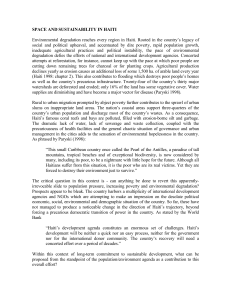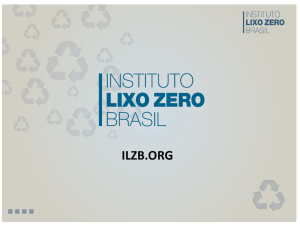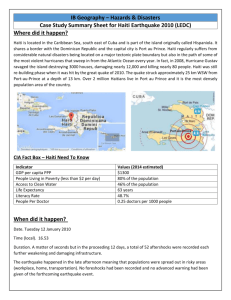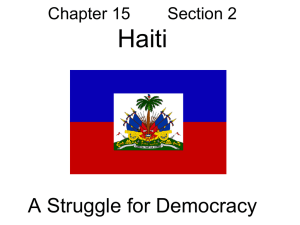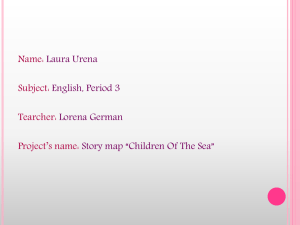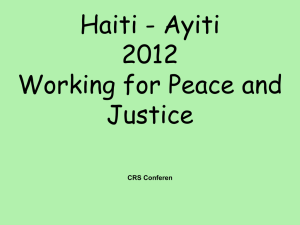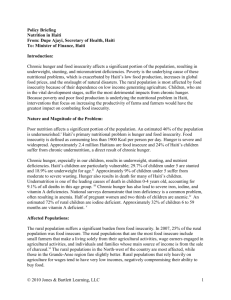Once we`ve determined that you are eligible for
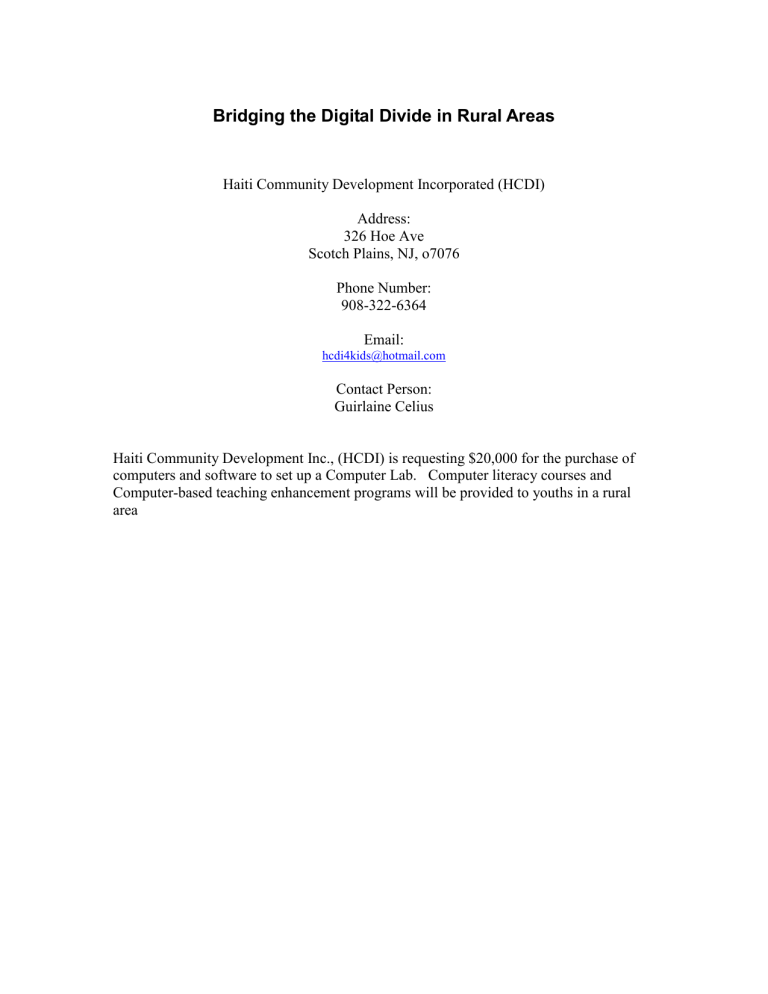
Bridging the Digital Divide in Rural Areas
Haiti Community Development Incorporated (HCDI)
Address:
326 Hoe Ave
Scotch Plains, NJ, o7076
Phone Number:
908-322-6364
Email: hcdi4kids@hotmail.com
Contact Person:
Guirlaine Celius
Haiti Community Development Inc., (HCDI) is requesting $20,000 for the purchase of computers and software to set up a Computer Lab. Computer literacy courses and
Computer-based teaching enhancement programs will be provided to youths in a rural area
1 Project Goals
To overcome poverty and function effectively in the emerging global economy, one must master a new set of knowledge and competencies. These include basic academic skills such as literacy, foreign language, math and science skills and the ability to use information and communication technology. Each person needs to learn how to create, apply, analyze and synthesize knowledge working individually or in a group all throughout their lifetimes.
HCDI (Haiti Community Development Inc.) is an organization committed to providing worldclass education in poor rural areas. To fulfill its mission, HCDI has determined that the provision of computer technology to these areas is a necessity. Since 1997, HCDI has built and operated an
Elementary school in Bongnotte, a rural section of Leogane, Haiti. On January 11, 2002, HCDI was one of 34 winners (out of the 2,400 participants) of the World Bank’s 2001 Development
Market Place competition. HCDI’s submission was voted as one of the most innovative and replicable proposals for alleviating poverty around the world. HCDI won an implementation seed grant for its “Solar-Powered Wireless Internet for Rural Education” proposal.
2 Project Description
This project will provide hundreds of students in rural schools in the town of Leogane and surrounding areas with the opportunity to make use of computers and gain access to educational resources that otherwise are completely out of reach.
We plan to use computers, software, videos and other audio-visual equipment as tools for improving basic skills in reading and writing and for providing comprehensive training in the use of computers. Students will be able to have easy and regular access to the computers and to basic skills software. We anticipate that effective use of technology will lead to significant gains in math, science, reading, and language skills.
Communication Infrastructure.
Our communication infrastructure consists of solar-powered wireless Internet access using a satellite-based system. Using the sun’s energy and our backup power system, electricity is generally available to us. The fact that the school has Wireless Internet connection means that the students and teachers can connect to the Internet at basically any time and from a number of
PCs. This project will leverage this existing infrastructure by setting up a computer room consisting of at least 15 networked computers connected to an assigned server and printer.
The computer lab will be made accessible to the students at all times. For example even during mid-day recess and during their leisure times, and on weekends, students and teachers will be encouraged to use the computers. . In addition to informal learning, formal training on the uses of computers and various software and training on the Internet will be provided. Eventually we would like to open the computer training program to the community at large. A small fee will be charged to the members of the larger community for use of the facility. Our ultimate goal is to encourage people to make use of the computers to acquire knowledge and skills and to make the computer lab sustainable.
2.1 Using technology to enhance learning.
This section provides an illustrative example of the kinds of learning activities that the computer lab will make possible. The rural countryside of Haiti offers students a wealth of potential scientific experiments and projects. Modern computer and information technologies will assist us in our effort to encourage students in exploring the biological diversity of their environment and to integrate findings with knowledge available globally. We intend to guide the students in collecting and recording information on living things. Students will be encouraged to draw or take pictures of and document different animals, birds, invertebrate, and plant populations in their immediate surroundings. They will keep field notebooks on which to write and record their own observations of different animals, birds, insects and their behavior (ex. - eating, sleeping, mating, and living habits). We will guide them in recording differences and similarities and identifying physical attributes such as size, shape and color. For the plants, the students will be encourage to interview community elders to learn about their medicinal uses.
Teachers will develop lessons plans that guide students in collecting additional information on the
Internet about these living organisms to enhance and enrich the learning experience.
The students will learn to organize and enter their data and findings into databases. Using drawings, pictures, and clip arts, they will learn to put together audio-visual presentations and web publications.
2.2
Using technology to promote culture
Many of Haiti’s treasures are contained in the minds of its people – in the endless assortment of stories, riddles, and proverbs that convey a timeless wisdom. To hear those stories is to become enchanted by them, drawn to their mystery. Students will be encouraged to preserve the stories of the past by interacting with their community elders and using their technological skills to document the stories on the computer. Students will also be encouraged to write about their own personal stories. All writing will be typed using the computer.
Cultural exchange will be promoted by encouraging students to develop (e-pal) friends using email correspondence. A formal liaison between the Haiti school and a school in the U.S will be established to promote such exchange. Students from both schools will exchange information using e-mail and will access information using websites. We are working with NJ Haiti Partners of the Americas as a partner organization to link up with an elementary school in NJ.
2.3
Using technology to promote language
In rural Haiti, the children are only fluent in Creole. Lesson videos, Interactive Multimedia software, DVD movies with subtitles will be used in teaching French as a Second Language and
English as a Second language to the students.
2.4
Using technology to promote reading and writing
The students will be encouraged to become creators of content. They will be encouraged to express and communicate their ideas in writing in their mother tongue (Creole) as well as practice their communication skills in the foreign languages that they will be studying (French and
English). Students will use various computer software to sharpen their reading, writing, and language skills. Using the school web site portal, students will be guided on the Internet to a large, rich, easily accessible knowledge base.
2.5 Using technology to promote healthy group dynamics and teamwork.
Students will be encouraged to work in small groups of 2 to 3 students on the computer to facilitate learning and to promote healthy group dynamics. The older students will then be assigned to facilitate group projects with younger students.
3 Financial Support
This section describes the program budget.
Items
Computer and Audio Visual Equipment
10 computers
2 Printers
1 Scanner
1 Projector
Printing supplies (cartridges, paper)
Software
Shipping Costs and Custom Duties
Travel
Subtotal
Total Project Cost
Subtotal
Cost
$12,000
1,000
500
5,000
500
1,000
$20,000
3,500
1,500
$5,000
$25,000
Source of Funding
Global Giving
Global Giving
Global Giving
Global Giving
Global Giving
HCDI
HCDI
HCDI


